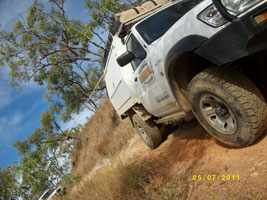SISODRV201A Townsville - Drive AWD/4WD Vehicle on Gravel Roads

Fra AUD
395,00 AU$
- Varighed: 8 Timer (Ca.)
- Produkt kode: tvlle sisodrv201a
This is our booking system. For all of our courses and tours see our main website at www.djolsen.com
Payment online is via credit card or EFT. If you would like to pay on invoice and have, or would like a vendor arrangement with us, please click on the contact us button. We would be very happy to setup a preferred supplier agreement with your company. Simply click on the contact us button.
1. Determine vehicle characteristics.
1.1. Determine the structural, handling and operational features and characteristics of the vehicle.
1.2. Determine the purpose and use of front wheel hubs.
1.3. Identify factors affecting tyre size, fitment, rating, and pressure.
1.4. Identify recovery points, tie down points and mounting features of the vehicle.
1.5. Identify hazards associated with incorrect use of vehicle features or equipment.
2. Perform pre operational checks.
2.1. Perform pre start checks according to organisational policies and procedures, relevant legislation and manufacturer's specifications.
2.2. Check and adjust tyre pressure according to expected terrain and manufacturer's recommendations.
2.3. Make required adjustments to establish appropriate driving position.
2.4. Secure loads as required according to organisational policies and procedures relevant legislation.
3. Operate vehicle.
3.1. Select and engage gear and devices appropriate to the terrain and any identified hazards.
3.2. Maintain traction according to the features of the vehicle and requirements of the terrain.
3.3. Apply appropriate braking techniques to maintain traction according to the features of the vehicle and requirements of the terrain.
3.4. Inspect water crossings for depth, flow rate and solidity of base prior to making crossings.
3.5. Negotiate water crossings using appropriate speed, gear selection and device engagement while maintaining safety of vehicle, personnel and environment.
4. Change wheels.
4.1. Locate jack and position according to manufacturer's specifications, organisational policies and procedures and relevant legislation.
4.2. Remove and replace wheel according to manufacturer's specifications, organisational policies and procedures and relevant legislation
4.3. Report or repair flat tyre according to manufacturer's specifications, organisational policies and procedures and relevant legislation
5. Complete operations.
5.1. Park and shut down vehicle according to manufacturer's specifications, organisational policies and procedures and relevant legislation
5.2. Report faults and malfunctions according to organisational policies and procedures.
5.3. Clean and store vehicle and equipment according to organisational policies and procedures.
5.4. Complete and submit documentation according to organisational policies and procedures.
Payment online is via credit card or EFT. If you would like to pay on invoice and have, or would like a vendor arrangement with us, please click on the contact us button. We would be very happy to setup a preferred supplier agreement with your company. Simply click on the contact us button.
1. Determine vehicle characteristics.
1.1. Determine the structural, handling and operational features and characteristics of the vehicle.
1.2. Determine the purpose and use of front wheel hubs.
1.3. Identify factors affecting tyre size, fitment, rating, and pressure.
1.4. Identify recovery points, tie down points and mounting features of the vehicle.
1.5. Identify hazards associated with incorrect use of vehicle features or equipment.
2. Perform pre operational checks.
2.1. Perform pre start checks according to organisational policies and procedures, relevant legislation and manufacturer's specifications.
2.2. Check and adjust tyre pressure according to expected terrain and manufacturer's recommendations.
2.3. Make required adjustments to establish appropriate driving position.
2.4. Secure loads as required according to organisational policies and procedures relevant legislation.
3. Operate vehicle.
3.1. Select and engage gear and devices appropriate to the terrain and any identified hazards.
3.2. Maintain traction according to the features of the vehicle and requirements of the terrain.
3.3. Apply appropriate braking techniques to maintain traction according to the features of the vehicle and requirements of the terrain.
3.4. Inspect water crossings for depth, flow rate and solidity of base prior to making crossings.
3.5. Negotiate water crossings using appropriate speed, gear selection and device engagement while maintaining safety of vehicle, personnel and environment.
4. Change wheels.
4.1. Locate jack and position according to manufacturer's specifications, organisational policies and procedures and relevant legislation.
4.2. Remove and replace wheel according to manufacturer's specifications, organisational policies and procedures and relevant legislation
4.3. Report or repair flat tyre according to manufacturer's specifications, organisational policies and procedures and relevant legislation
5. Complete operations.
5.1. Park and shut down vehicle according to manufacturer's specifications, organisational policies and procedures and relevant legislation
5.2. Report faults and malfunctions according to organisational policies and procedures.
5.3. Clean and store vehicle and equipment according to organisational policies and procedures.
5.4. Complete and submit documentation according to organisational policies and procedures.



